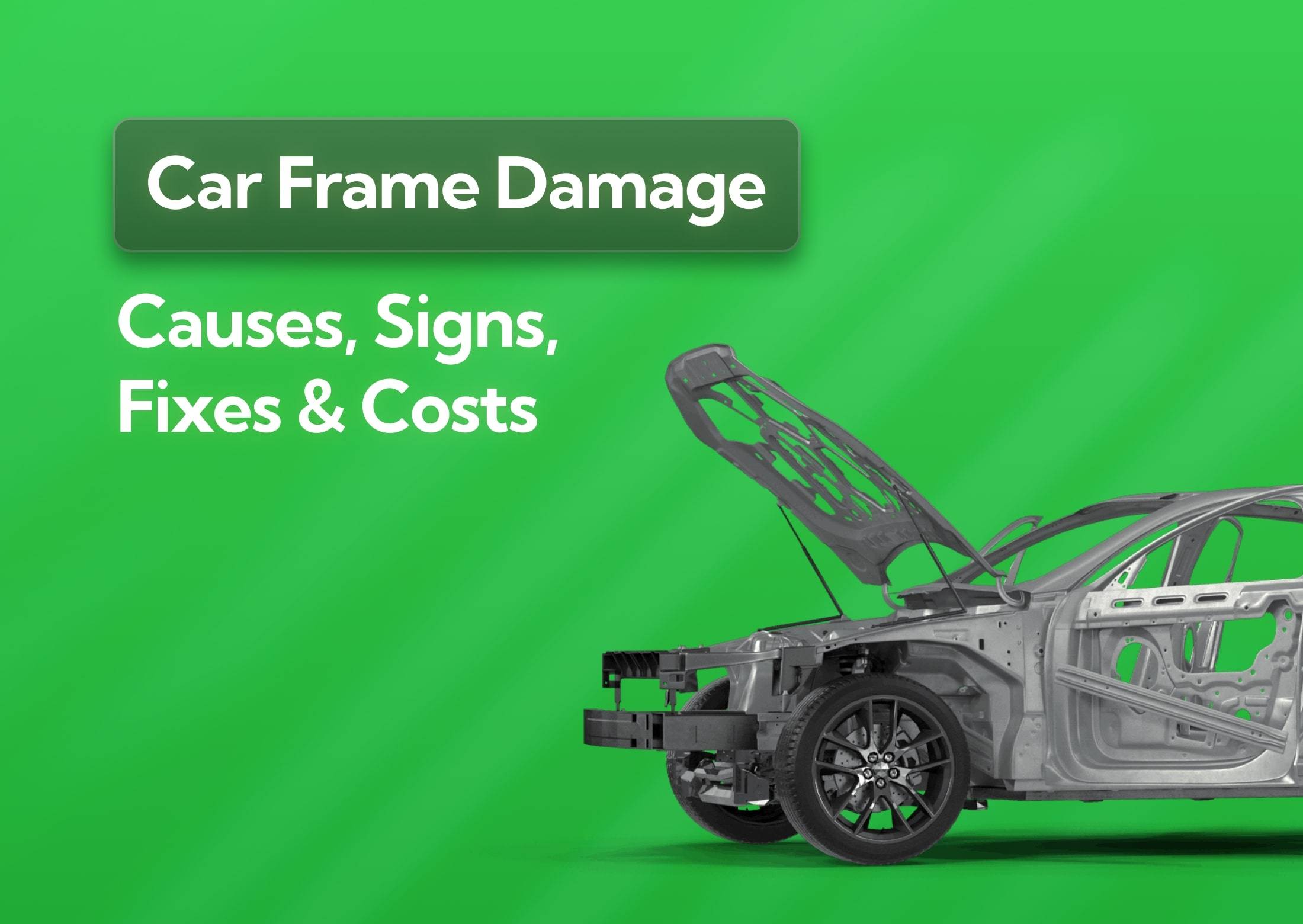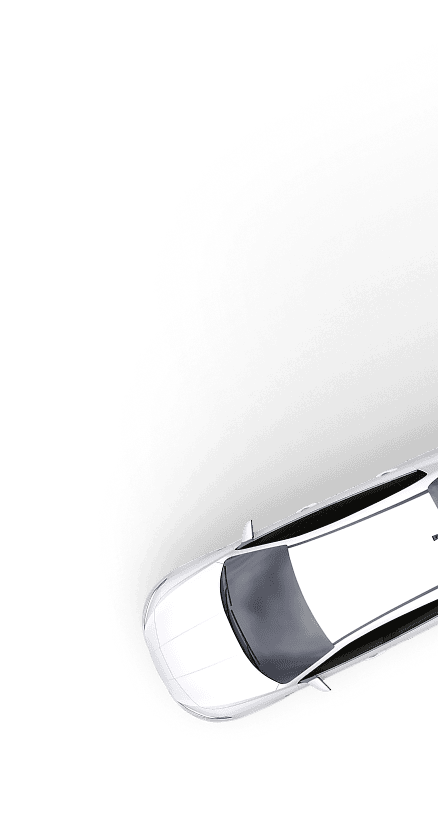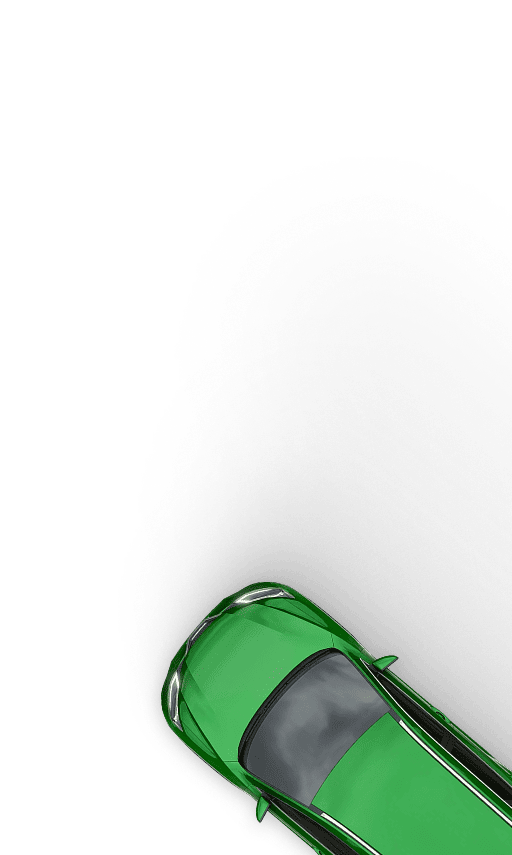Car Frame Damage: Causes, Signs, Fixes and Costs
Learn all about car frame damage in this comprehensive guide: how you’ll know, what might’ve caused it, what you can do to fix it and whether that fix is even worth your while, plus our best preventative tips.
Last updated: 27th November, 2025

Anthony Sharkey is COO at New Reg Limited (Car.co.uk, Trader.co.uk, Garage.co.uk), driving innovation in vehicle recycling, logistics, and customer experience.

Listen to this story
Frame damage sounds a bit dramatic, but it doesn’t always mean the car’s finished. The frame (or chassis) is the main structure everything else bolts onto. When it’s straight and solid, the car drives as it should. When it’s bent, rusted or cracked, problems start to spread into other places.
Since the frame isn’t a cosmetic component, any damage matters. Some issues only affect alignment but after a heavy collision, severe pothole impact or long-term corrosion, it might cause hidden problems you don’t necessarily notice right away.
Most structural damage comes from crashes, deep rust, kerb impacts and previous repairs that weren’t properly done. And you’ll notice it by uneven tyre wear, the car pulling to one side, clunks over bumps or panel gaps that suddenly look “off”.
Repair costs swing wildly. Minor straightening might be a few hundred quid; major structural restoration runs into the thousands and might make the job uneconomical. But you have to address structural issues. If you don’t, it won’t drive or protect you in a crash the way it should.
This guide breaks down what causes frame damage, how to spot it early and what your realistic repair and replacement options look like.
What's in this article
What are the causes of car frame damage?
99% of the time, frame damage comes down to one of five things: collisions, rust/corrosion, overloading with weight, age-related wear and shoddy repair work. They’re all fairly common, but each one affects the chassis in a slightly different way.
- Frame bending and twisting from collisions: Frontal, rear-end and side-impact accidents all put enormous force through the frame. Even a “moderate” crash might twist key structural points or create hairline cracks you won’t spot without a ramp or specialist equipment. While the cosmetic aspect of the crash might not matter to you, if the frame moves even a few millimetres, it can throw off wheel alignment and put tremendous stress on the suspension components. That’s why undetected collision damage tends to show up later as uneven tyre wear and poor handling.
- Frame weakening from rust and corrosion: Water, road salt and damp air gradually eat away at your car’s metal. This creates tiny perforations, which weaken the structure over time. The worst corrosion tends to form around mounting points, suspension brackets, sills and areas where mud and moisture collect. Early signs include bubbling metal, orange flakes, soft spots and rust starting to appear near weld seams. If you don’t address it, it’ll weaken the load-bearing parts of the chassis and make the car extremely unsafe while driving (and even more so during impact).
- Chassis damage from overloading and stress: Exceeding the manufacturer’s limits or towing a trailer that’s too heavy pushes strain into the frame every time the vehicle moves. When weight isn’t distributed properly, certain areas of the chassis take more punishment than others, causing the frame to bend and sag over time. Workers whose vehicles routinely carry heavy kit and tradespeople who overload their trucks and vans are generally the kinds of people who deal with this issue.
- Metal fatigue and frame wear over time: Even without crashes or abuse, the frame flexes slightly every time you drive. Years of potholes, speed bumps, rough roads and constant vibration eventually take a toll. It starts with tiny cracks and weak points, but the repeated stress exacerbates the structural problems. This is why older and higher-mileage cars are naturally more at risk because their frames have endured more cumulative flexing.
- Structural damage from improper repairs: Misaligned straightening, weak or poorly placed welds, incorrect replacement parts and rushed workmanship all weaken the structure after a repair job. DIY fixes and inexperienced workshops are the usual culprits. The car may look fine on the surface, but again this is not a cosmetic issue. If the geometry is off or the metal hasn’t regained full strength, your chances of further damage are far greater and your car’s safety features won’t work like they’re supposed to if you’re involved in an accident.
What are the signs of car frame damage?
If your frame is damaged, you’ll almost always notice something, whether that ‘something’ is visual, performance-related or sensory. Maybe the way it drives has changed. Maybe certain panels look a little out of place. Or maybe your door doesn’t shut all the way.
The most important thing to do when you notice these small clues is to get the car looked at professionally. They’re your first warning that something structural underneath isn’t as straight or as strong as it should be.
Let’s take a look at each indicator more in-depth:
- Frame misalignment: A lot of times with structural damage, doors, the boot or the bonnet suddenly feels harder to close because the latches and gaps no longer line up cleanly with the frame’s perimeter. If the chassis itself is bent or shifted out of alignment, the car may pull to one side even after you’ve had a proper wheel alignment. And if you look at the car from the side or rear, you might also notice the body sitting slightly uneven.
- Visible frame deformation: This is the easiest sign to spot. You might see bent metal, warped rails, crushed sections or areas where the frame no longer sits straight under the car. Sometimes the deformation is obvious after a crash, but it can also show up as ripples, creases and sharp kinks in the structure or near suspension mounting points that aren’t supposed to be there.
- Uneven tyre wear from frame damage: When the frame is out of shape, the wheels don’t sit at the correct angles. That throws off camber, toe and tracking and causes the tyres to wear down faster on one side than the other. Tyres take a bit of time to show wear, so by the time you notice it, the underlying structural problem has usually been there for a while.
- Suspension and steering irregularities: A damaged car frame throws the whole suspension geometry out of balance, and you’ll feel it in how the car behaves. The steering will either feel loose or wobbly, and the car might veer off slightly on straight roads. Over bumps, you’ll hear rattles and vibrations in the chassis because components are no longer sitting at the angles they were designed for. And if the frame’s distorted enough, you might even notice unevenness in the ride height.
- Misplaced or stressed components: When the frame shifts, the parts bolted to it shift as well. Look closely at the bumpers, fenders and subframe. If they suddenly have widened gaps or appear slightly twisted, the structure underneath has almost definitely moved. Also inspect weld points and attachment areas because you might notice the metal looks like it’s under stress or has already cracked.
How to fix car frame damage
How you fix a damaged car frame depends on exactly what’s wrong and how severe it is. So the first step is an assessment. From there, the mechanic will used hydraulic tools and specialised equipment to straighten the bent sections. Then, they’ll weld and refinish compromised areas.
“Mechanic” is the key word here. Unless the damage is completely non-structural and only affects non-critical areas of the frame (e.g. a small dent to the outer bumper) this isn’t a job you can DIY your way out of.
When you take the car to a garage, these are the steps a good mechanic will go through to restore your vehicle:
- Straighten the frame. A proper body shop will mount your car onto a hydraulic frame machine, which locks the vehicle in place. From there, technicians use hydraulic rams, chains and clamps to apply controlled pressure to the bent sections. The frame is pulled millimetre by millimetre using factory measurements as a reference. Modern garages use laser or computer-based measuring systems to check alignment in real time, because even a small deviation can throw off handling, suspension geometry and crash performance.
- Weld and reinforce the frame. Welding comes into play when you’ve got cracks, torn metal, split seams or rusted-through sections. In those cases, the weakened areas need to be repaired or replaced before the frame can safely carry loads again. To do this, a technician will cut out any compromised metal, clean the surrounding area, and use MIG or TIG welding (the two most common techniques for structural work) to rebuild the section. New steel plates, brackets and/or patch panels are shaped and welded in, then ground smooth so the repair blends into the existing structure. Done properly, this restores the frame’s structural integrity by creating a continuous, rigid connection between the old and new metal.
- Replace damaged components. Sometimes the damage is too severe (or too localised) for straightening or welding to be feasible. In those cases, the mechanic removes the damaged piece and installs a new one. Subframes, crossmembers and crash rails are the most common replacement items and, unfortunately, they aren’t cheap. A replacement crossmember might run £500 to £1,000+, while a full front or rear subframe can easily cost £800 to £2,000+ once you factor in labour, suspension/steering component removal and a full alignment after it’s done.
- Get a professional inspection. A proper inspection is critical because most frame damage isn’t visible from the outside. Bent rails, twisted mounting points, hidden cracks and internal corrosion are things you can only spot with ramps, measuring equipment and someone who knows exactly where to look. Plus, they’ll be able to plan out the best approach for your repair.
- Avoid cosmetic fixes. Some garages try to mask structural problems with quick cosmetic touches. Maybe they’ll straighten a panel. They might fill a crease, or adjust trim so it “looks” right. That doesn’t fix the chassis underneath. The only way you’ll restore the car’s long-term safety is to repair the actual structural issue. So when you get a quote, make sure they focus on the specifics of your frame damage and give you a detailed action plan.
What the experts say

Steven Jackson OBE
How much does it cost to fix car frame damage?
On the low end, minor straightening and alignment costs £300 to £800 to repair. That’s usually enough for small bends or twists that only need hydraulic pulling and a measurement check.
On the high end, a full structural restoration with welding, reinforcement and major parts replacements (like subframes or crossmembers) will cost £2,000 to £3,000 or more, depending on the vehicle and how much labour is involved.
Typical cost ranges for frame repair (UK, 2025)
| Repair type / scope | What’s involved | Typical cost range |
|---|---|---|
| Minor straightening and alignment | Small bends or twists in the chassis, using hydraulic frame-straightening equipment | £300 to £800 |
| Moderate frame repair / reinforcement | More than a tweak – may involve welding, reinforcing weakened areas, minor subframe sections | £800 to £2,000 |
| Subframe or major structural component replacement (front/rear subframe, crossmembers, crash rails) | Remove suspension/engine supports if needed, replace part, re-align everything, new welding/bolting, possibly new suspension or mounting parts | £800 to £2,000+ |
| Severe damage / full restore (heavy corrosion, twisted chassis, multiple sections) | Multiple repairs, possible part replacements, welding, straightening, full safety and alignment work, sometimes exceeding to value of car | £2,000 to £3,000+ |
What drives this variation? A few things:
- Scope of damage: A simple misalignment is cheap. Once you need structural welding or parts replacement, costs rise into the thousands almost 100% of the time.
- Parts required: Subframes and crash rails vary in cost depending on car make and age, but generally cost between £100 and £300 without accounting for labour. For rare and specialised cars, they tend to be more expensive.
- Going labour rates in your area: In cities, £100+ per hour is the norm for a standard vehicle. If you live in a smaller town, it’s sometimes possible to get into the £40 to £80 range.
- Labour complexity: Removing and refitting suspension, engine mounts, and other components adds hours; labour rates (garage to garage) affect the final bill.
- Vehicle type and design: Larger cars like trucks and SUVs, and high-performance cars with complicated subframes are pricier to repair because the replacement parts are more expensive, then they require more labour hours on top of that.
- Extent of inspection and post-work alignment: A thorough check complete with laser measurement, full wheel alignment and suspension geometry adds cost but is the only way to make sure the car’s safe to hit the road again.
Is it worth fixing car frame damage?
Fixing car frame damage is worth the cost in a lot of cases, but it depends heavily on how repair costs compare to the car’s current value and how much life you can realistically get out of it afterwards.
Structural repairs aren’t cheap, so the decision usually comes down to simple maths: if the repair restores a safe, reliable car for a sensible price, it’s worth doing. If the fix costs more than the car’s worth (or leaves you with long-term doubts about safety), it’s smarter to move on.
When fixing a car with frame damage is worth it
It makes sense to repair the car when the numbers and the condition line up in your favour:
- The car is newer and still holds strong market value. If the vehicle is worth significantly more than the repair bill, repairing it keeps you financially ahead.
- The damage is localised and structurally straightforward. A bent rail, minor misalignment, or a cracked mounting point is often repairable without rebuilding half the car.
- Replacement parts are affordable and available. Some cars have bolt-on subframes or crossmembers that make repairs quicker and cheaper.
- You’re able to keep the car for several more years. If you can get at least five more years of good useful life out of it, it’s a sound investment.
- A trusted shop confirms the frame can be returned to factory spec. Precision matters. If the garage can restore full structural integrity, the car will drive and protect you exactly as it should.
When scrapping your car is the better option
It’s better to scrap your car when the damage is too severe or the economics fall apart:
- Repair costs exceed 50% of the car’s value. The ultimate deciding factor. If you hit that threshold, scrap your car now because otherwise, you’re putting more money in than you’ll ever get back.
- The frame is twisted, heavily rusted, or cracked in multiple areas. Major structural compromise is expensive to fix and may never perform like a healthy chassis.
- The car is older, high-mileage or already near end of life. Even a perfect repair won’t add much long-term value to a tired vehicle. If the car is 10+ years old or has 150,000+ miles on it, it’s almost always better to kiss it goodbye.
- You’d need multiple new structural components. A new subframe, rails, crossmembers and extensive welding can easily reach £2,000 to £3,000+, which many older cars can’t justify.
- Safety confidence is low, even after repair. If the car has been in a serious collision, sometimes the safest and most financially sensible choice is to let it go even if your insurer didn’t write it off.
Tips to prevent car frame damage
If you take proper care of your car and practise good driving habits, you’ll be able to avoid practically every type of frame damage, with the obvious exception of not-at-fault collisions.
That really boils down to five practical tips:
Avoid collisions by practicing defensive driving.
The simplest way to protect your frame is to avoid the kind of impacts that bend it in the first place.
- Keep a safe following distance.
- Anticipate what other drivers might do.
- Give yourself enough time to brake smoothly rather than slamming on.
- Check your mirrors often.
- Watch for sudden lane changes.
- Approach junctions with a healthy dose of caution.
The fewer surprises you face on the road, the lower your risk of a frame-bending collision.
Protect your frame from rust.
Rust weakens a frame from the inside out, so prevention matters. Washing the undercarriage at least once per month gets road salt and dirt out of there before they start eating into the metal, and a good coat of wax helps keep moisture off vulnerable areas.
Lots of drivers also choose anti-corrosion sprays or underbody coatings to add an extra barrier against rust. And if you can, park in a garage or covered spot to keep the car out of constant rain and humidity.
Avoid overloading your vehicle.
Weight limits exist for a reason. Exceeding them puts unnecessary strain on the chassis, especially if you’re taking it on long drives or rough roads.
Always stick to your manufacturer’s payload guidelines and distribute weight evenly when you are carrying heavy items. Keeping the load balanced prevents certain sections of the frame from taking more punishment than others.
Regularly inspect for signs of frame wear.
A quick visual check every 2 to 4 weeks goes a long way. Look for early clues of frame damage like uneven panel gaps, unusual tyre wear, rust around mounting points and anything underneath the car that looks out of place.
Run your eyes along the frame rails if you can safely access underneath. And if something feels off with the handling, there are strange noises coming from the underside or it’s visibly corroded, book a professional inspection ASAP.
Address small repairs promptly.
That brings us to our next point. Minor issues don’t stay minor for long when it comes to structural components. Even a slight misalignment might compromise your car’s safety in an accident, so you’re taking a chance every time you take the car out.
Beyond that, sorting early problems while they’re small keeps you from facing a much larger bill later. Like we’ve already detailed above, targeted repairs are only a few hundred quid, while extensive repairs will almost always cost you well into the four figures.
About Car.co.uk

Share on
Latest news & blogs






![How to Sell a Car Privately in the UK [2025]](https://stage-drupal.car.co.uk/s3/files/styles/media_section_large_teaser_mobile/public/2025-11/how-sell-a-car-privately-in-the-uk.jpg?itok=ubSHbYCJ)



